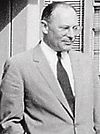You can help expand this article with text translated from the corresponding article in German. Click for important translation instructions.
|
| Helmut Hoelzer | |
|---|---|
| Helmut Hölzer | |
 Helmut Hoelzer in Huntsville, Alabama Helmut Hoelzer in Huntsville, Alabama | |
| Born | (1912-02-27)February 27, 1912 Bad Liebenstein, Thüringen, German Empire |
| Died | October 12, 1996(1996-10-12) (aged 84) Huntsville, Alabama, United States |
| Alma mater | Technische Hochschule Darmstadt |
| Known for | Designing an electronic stabilization computer and related test simulator for the V-2 rocket control system. |
| Awards | Paul Ehrlich and Ludwig Darmstaedter Prize (1963) |
| Scientific career | |
| Fields | Electrical Engineering, Applied mathematics |
| Institutions | 1933-tbd: teaching 1939: Telefunken (Berlin) |
Helmut Hoelzer was a Nazi Germany V-2 rocket engineer who was brought to the United States under Operation Paperclip. Hoelzer was the inventor and constructor of the world's first electronic analog computer.
Life
In October 1939, while working for the Telefunken electronics firm in Berlin, Hoelzer met with Ernst Steinhoff, Hermann Steuding, and Wernher von Braun regarding guide beams for a flying body. In late 1940 at Peenemünde, Hoelzer was head of the guide beam division (assistant Henry Otto Hirschler), which developed a guide-plane system which alternates a transmitted signal from two antennas a short distance apart, as well as a vacuum tube mixing device (German: Mischgerät) which corrected for momentum that would perturb an object that had been moved back on-track. By the fall of 1941, Hoelzer's "mixing device" was used to provide V-2 rocket rate measurement instead of rate gyros.
Then at the beginning of 1942, Hoelzer built an analog computer to calculate and simulate V-2 rocket trajectories Hoelzer's team also developed the Messina telemetry system. After evacuating Peenemünde for the Alpenfestung (Alpine Fortress), Hoelzer returned to Peenemünde via motorcycle to look for portions of his PhD dissertation prior to surrendering to United States forces at the end of World War II.
Hoelzer was a student of Alwin Walther.
Family
One of his grandchildren is Olympic swimmer Margaret Hoelzer.
References
- ^ Wade, Mark. "Hoelzer". Astronautix. Archived from the original on December 27, 2016. Retrieved October 19, 2008.
- "Of current interest: U.S. space probers get powerful new computer". IEEE Electrical Engineering. 79 (8): 698–699. 1960. doi:10.1109/EE.1960.6432788. Retrieved December 17, 2024.
- Tomayko, James E. "Computers Take Flight: A History of NASA's Pioneering Digital Fly-by-Wire Project" (PDF). p. 13. Archived from the original (PDF) on 2004-07-19. Retrieved October 18, 2008.
- Tomayko, James E. (July 1985). "Helmut Hoelzer's Fully Electronic Analog Computer". Annals of the History of Computing. 7 (3): 227–240. doi:10.1109/mahc.1985.10025. S2CID 15986944.
- ^ Ordway, Frederick I III; Sharpe, Mitchell R (1979). The Rocket Team. Apogee Books Space Series 36. New York: Thomas Y. Crowell. pp. 46, 294. ISBN 1-894959-00-0.
- ^ Biener, Klaus (August 1999). "Alwin Walther – Pionier der Praktischen Mathematik". RZ-Mitteilungen (18): 60–62. doi:10.18452/6275.
- Ernst Steinhoff
- ^ H. Otto Hirschler, 87, Aided Space Program
- Ley, Willy (1951) . Rockets, Missiles and Space Travel (Revised edition 1958). New York: The Viking Press. p. 257.
- Neufeld, Michael J. (2013-09-10). The Rocket and the Reich: Peenemunde and the Coming of the Ballistic Missile Era. Smithsonian Institution. p. 138. ISBN 9781588344663.
- Ulmann, Bernd (2013-07-22). Analog Computing. Walter de Gruyter. p. 38. ISBN 9783486755183.
- Tomayko, James E. (1985). "Helmut Hoelzer's Fully Electronic Analog Computer". IEEE Annals of the History of Computing. 7 (3): 227–240. doi:10.1109/MAHC.1985.10025. S2CID 15986944.
Sources
- Neufeld, Michael J (1995). The Rocket and the Reich: Peenemünde and the Coming of the Ballistic Missile Era. New York: The Free Press. pp. 104, 106, 107, 140.
- p. 107
- p. 140
- p. 104
- p. 106
- p. 106